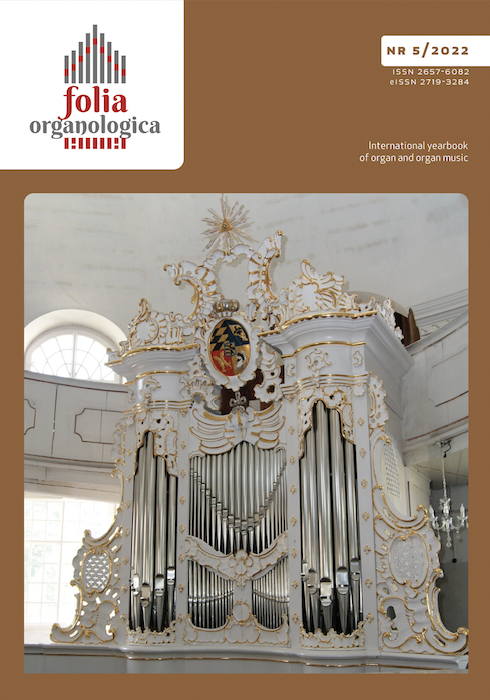Indeks organów istniejących w kościołach i kaplicach diecezji gliwickiej
Index of Organs in Churches and Chapels of the Diocese
of Gliwice
Author(s): Franciszek KoenigSubject(s): History, Fine Arts / Performing Arts, Cultural history, Music, History of Art
Published by: Uniwersytet Opolski
Keywords: silesian organs; organbuilding in Silesia; organ builders; action; windchests
Summary/Abstract: In the Diocese of Gliwice, organs are located in 117 parish churches (including the cathedralchurch and the minor basilica in the Sanctuary of Our Lady in Rudy), 7 filial churches,4 historic churches and 1 rector's church. In addition, pipe organs are located in a garrisonchurch and in 3 chapels. One of the instruments, originally in the historic church in ZawadaKsiążęca, is deposited in the Museum of Silesian Organs at the Academy of Music in Katowice.In the diocese, there are also 2 churches with two organs each: St. Hyacinth's Churchin Bytom (the upper church and the lower church of St. Joseph) and St. Joseph’s Church inZabrze (a large instrument in the choir section of the church and a smaller one on the sideof the presbytery which until 2003 was located in the crypt of the church). Among the listedorgans, there are 16 translocated instruments – one during the interwar period and otherorgans in later years.Most preserved organs were built by the following companies: Rieger, also representedunder the name Gebrüder Rieger (29), Berschdorf (16) and Schlag und Söhne (12). Othercompanies to be mentioned are E. Kurzer and H. Hober (6), K. Spiegel and C. Volkmann(5) and J.M. Haas and W. Truszczyński (4). The list of organ builders in the diocese also includes:D. Biernacki, E. Cichoń, A. Czopka, Gebrüder Walter, J. and V. Hawel (J. Hawel undSöhne), A. Kamiński, R. Landau, J. Maliński and P. Gielsok, W. Sauer, G.W. Scheffler and theWalcker company. Companies such as B. Cepka, A. Führer, B. Göbel und Söhne, E. Horn,D. Kaczmarczyk, Kleis, Klimosz and Dyrszlag, L. Michalik, M.R. Müller, Norks Orgel-Harmoniumfabrik,J. Siedlar, M. Urbanczyk, Verschueren, F.J. Weiss, E. Wilhelm and Z. Zasadaall built one instrument each. Meanwhile, the builders of 6 instruments remain unknown.As for organbuilding intensity in particular periods, most of the preserved organs werebuilt in the interwar years, i.e. from 1918 to 1943 – a total of 44 instruments (33%) comefrom this period. 31 organs (23%) were built at the end of the 18th or in the 19th centuries.In the first period of the 20th century, between 1900 and 1918, 26 instruments (20%) werecreated and after 1945, 34 instruments (25%) were built. Thus, it is evident that most of theorgans come from the interwar years even though this period covers only about 20 years. Itis worth mentioning that when we also include in the count organs built at the beginning ofthe 20th century, we reach as many as 70 instruments coming from the first half of the 20thcentury (1900-1943) which constitutes almost 52% of all preserved organs.The size of an organ is first expressed in the number of its voices. Among the listedinstruments, there are 31 organs with up to 10 voices, while the highest number of 46 instruments(approx. 34%) has a dozen or so voices. There are 27 instruments with morethan 20 voices, 13 organs with more than 30 voices, 10 instruments with over 40 voices and6 organs with over 50 voices. The three instruments having the most voices are the ones inthe churches of St. Bartholomew in Gliwice, of St. Hyacinth in Bytom (60 voices each) andthe 65-voice Carl Berschdorf 's organ in the Church of St. Barbara in Bytom.Another measure of organ size is the number of keyboards. The last instrument mentionedis the only one in the diocese that has 4 manuals. Among other discussed instruments,there are 3 choir organs (Brusiek, Łącza and Zacharzowice) and 25 instruments with only1 manual and a pedalboard. Most of the organs (83 – approx. 62%) have 2 manuals, while22 instruments include 3.In the presented organ instruments, 4 types of actions are used: mechanical (35 instruments),pneumatic (67 instruments – approx. 50%), electropneumatic (28 organs) and electromagnetic(only 4 instruments).The last criterion of the numerical summary is the question of windchest construction.Cone chests are the most common (69 instruments – approx. 51%). The next most numerousare slider windchests (36 organs – approx. 27%), followed by membrane chests withexhaust systems. In 6 instruments, the so-called einkanzellentaschenlade chests are used, in16 – chests with standing membranes and in 9 – chests with lying membranes. Two instrumentsuse windchests with lateral wedge bellows (Rieger organs from the beginning of the20th century), and one uses interesting windchests with diagonally hanged valves whichwere introduced by the Schlag und Söhne company at the end of the 19th century. Lastly,as a result of their extension, at least 3 organs use various types of windchests in their particularsections.
Journal: Folia Organologica. International yearbook of organ and organ music
- Issue Year: 2022
- Issue No: 5
- Page Range: 62-83
- Page Count: 22
- Language: English, Polish

